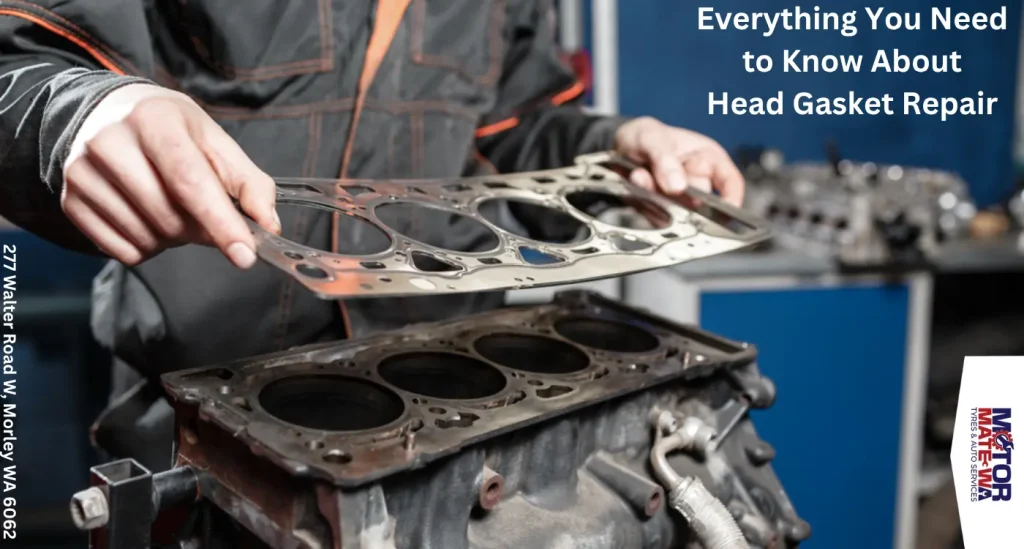Head Gasket Guide: Can A Blown Gasket Be Fixed & Does Sealer Work?

Your engine is running hot, steam hissing from under the bonnet, with “check engine” sign on your dashboard. You Google the symptoms and hit with the dreaded term: blown head gasket. But what does it mean? & can you fix it without changing your engine?
Head gasket failures are one of the most feared problems for any car owner. And there’s a good reason: it’s hidden, expensive, and easy to misdiagnose. But let us tell you that not all head gasket issues are the end of the road.
With the right know-how, you can figure what’s going on and take action before things go from bad to engine-dead. And Motor Mate WA is just going to equip you with that. So, you can detect the need for head gasket repair just the moment it arises.
Ready to learn? Let’s pop the bonnet on the truth.
What Is a Head Gasket and Why Is It So Important?
A head gasket is a small & flat engine component made with multi-layered steel. It sits between the engine block and the cylinder head.
Though little in size, its job is absolutely crucial for functioning of your car. Because it seals the combustion chamber, prevents oil and coolant from mixing, and maintains the pressure needed for your engine to function.
Without a healthy cylinder head gasket, your engine would overheat, lose power, and eventually stop working altogether. This thin little mate seals some of the most intense temperatures and pressures inside your engine.
You won’t realise its true importance until it stops working.
Why Does a Head Gasket Blow?
There are several reasons why a head engine gasket can fail. But the most common culprit is engine overheating. If your engine runs too hot for too long, the metal components expand beyond their limits & causes the gasket to fail.
Other causes include:
- Poor coolant maintenance
- Blocked radiators or faulty thermostats
- Over-torquing of the cylinder head bolts
- Corrosion from old coolant
- High engine loads or poor engine tuning
Once blown, the gasket can no longer do its job. And if you don’t detect it on time, it’ll lead to all kinds of trouble under the bonnet.
Symptoms of a Head Gasket Failure You Shouldn’t Ignore
Spotting the symptoms of a head gasket failure on-time can solve half of the problem. Because you can prevent the serio us damage this way & it’ll save you a heap of money and stress. Here are the red flags you should keep your eye on:
Symptoms of Blown Gasket | Why They Appear? |
White smoke from the exhaust | It is coolant entering the combustion chamber |
Engine overheating even when the coolant level is full | Oil is mixed in the coolant |
Milky oil under the oil cap or on the dipstick | Indicates coolant is mixing with engine oil |
Low coolant levels with no visible leak | It is vapourised in combustion chamber |
Rough idle or engine misfires | |
Bubbling in the coolant reservoir | Due to overheating in engine components |
If any of these symptoms appears, you should arrange a head gasket repair ASAP. Don’t leave it for tomorrow otherwise you’ll have to face serious engine damage.
Can You Still Drive with a Blown Head Gasket?
Technically, yes. But should you? Absolutely not.
Driving with a blown head gasket is like driving with a ticking time bomb. It puts extra strain on the cooling and lubrication systems, risks warping the cylinder head, and can even cause total engine failure. Even short trips can lead to catastrophic damage.
If you suspect you’ve got a gasket issue, park the car at suitable spot and call a mechanic. If you’re in Perth, get in touch with Motor Mate WA. We’ll sort it quickly and safely.
Is It Possible to Repair a Blown Head Gasket?
Yes, but not always. The longer you’ll wait for it, the more reduction in your chances.
A head gasket fix depends on how badly the gasket has failed and whether or not the damage has gone to the head or engine block. If caught early:
- The cylinder head can be removed and inspected.
- The gasket is replaced.
- The head is resurfaced for a tight seal.
This type of cylinder head gasket repair is labour-intensive. But it restores full engine function and longevity without replacement charges. However, if the engine block is cracked or warped, more extensive repairs or a cylinder head gasket replacement will be required.
How Much Does a Head Gasket Repair Cost in Australia?
Costs vary depending on your car’s make, model, and how much damage has occurred. But we can give you an approximate based on market rates.
Service | Estimated Cost |
Minor gasket repair (no machining) | $1,200 – $1,800 |
Full head gasket replacement | $2,000 – $3,500 |
Extensive engine rebuild | $3,500 – $6,000+ |
At Motor Mate WA, we provide detailed inspections before quoting. We’ll walk you through your options and give honest advice. No surprise fees, no unnecessary upselling.
How Long Does an Engine Gasket Repair Take?
If the job is straightforward and there’s no warping or cracks, a head gasket fix can be done in 1–2 days. But more complex jobs involving machining or extensive damage can take 3–5 days or more.
The process is given as:
- Disassembly: 2–4 hours
- Inspection & resurfacing: 1–2 days
- Reassembly & testing: 4–6 hours
Timing can also vary depending on parts availability and how busy the shop is. Ask these things from your mechanic beforehand to avoid surprises.
How Can You Prevent a Head Gasket Failure in the First Place?
YES, you can. Just develop few small but healthy driving habits and prevent major costs. Some expert-approved tips to avoid head and gasket issues are:
- Check coolant levels weekly and top up when needed.
- Use the correct coolant mix (don’t just use water).
- Replace coolant every 2 years or as per your logbook.
- Keep an eye on your temperature gauge. If it’s rising, pull over.
- Fix overheating problems (e.g., fans, radiator) ASAP.
- Service your car regularly at trusted places.
Think of prevention as a small investment that saves thousands down the track. Plus, it will keep your engine healthy & increase the resale value of your car.
Does Head Gasket Sealer Work or Is It Just Hype?
A head gasket sealer is a liquid chemical that claims to seal small leaks in gasket by hardening when exposed to engine heat. It’s is a temporary fix and is marketed for minor gasket leaks.
Honestly, we don’t recommend it but will discuss its working for your knowledge.
Pros:
- Inexpensive
- Easy to use (just pour into the radiator)
- Might stop minor leaks
Cons:
- Not suitable for major gasket failures
- Can clog radiators or heater cores
- Doesn’t last long-term
- Can mask serious problems
So, while it can buy you some time, don’t expect it to replace a real head gasket repair. It’s just like duct tape on a leaking pipe & not a proper solution.
Repair or Replace: Which Is Better for Cylinder Head Gasket Damage?
For minor leaks or early damage, a professional engine gasket repair is all you need. But if the cylinder head is cracked, warped beyond limits, or the engine block is damaged, you’ll need a full cylinder head gasket replacement.
It involves:
- Replacing the gasket and bolts
- Machining the head
- Pressure testing
- Reassembling and flushing the system
Yes, it costs more. But when the damage is escalated, it’s the only way to get long-term reliability and performance.
Got Gasket Trouble? Let’s Sort It Out.
Motor Mate WA: Your Local Experts for Head Gasket Repairs in Perth
At Motor Mate WA, we make engine gasket repair easy for you. From diagnostics to full head gasket fix, you can get trusted service of your engine. Our certified team in Morley offers clear advice, fair pricing, and industry-standard workmanship.
So, if your car’s steaming, overheating, or acting weird, take it to us. We’ll get to the root of problem and fix it right.
and drive with peace of mind tomorrow.
